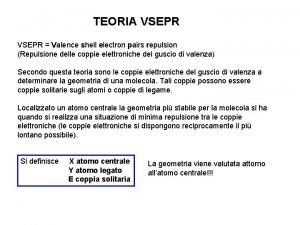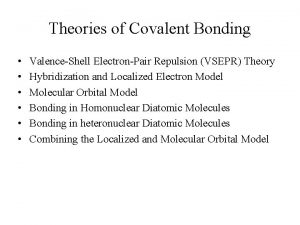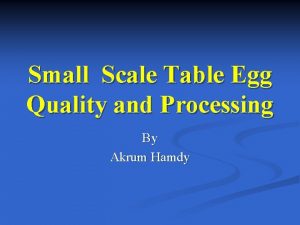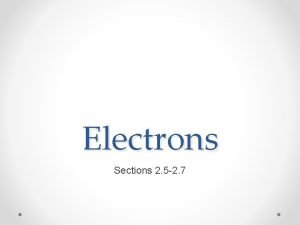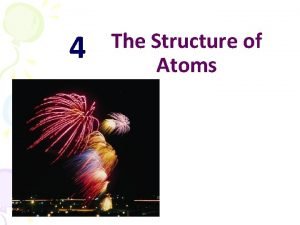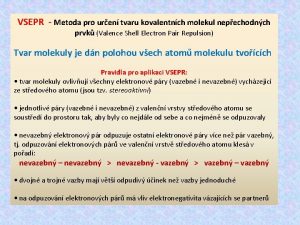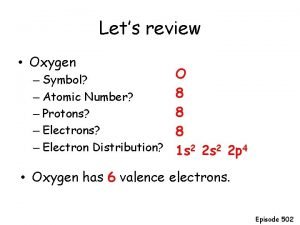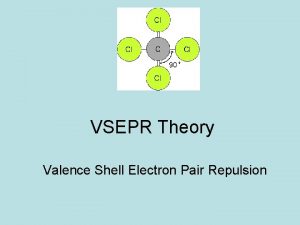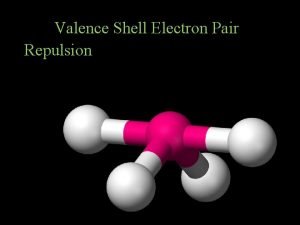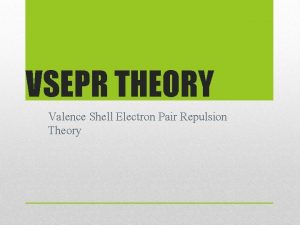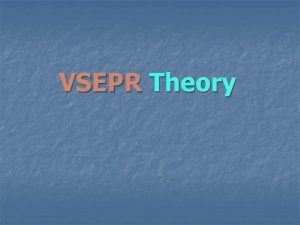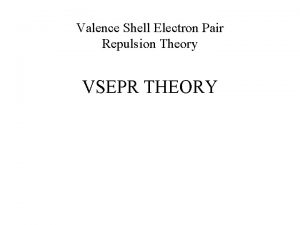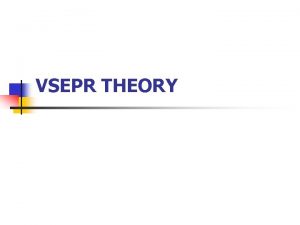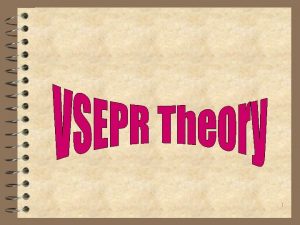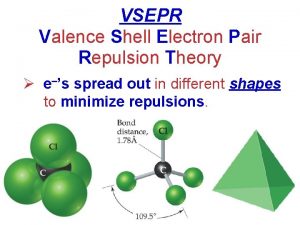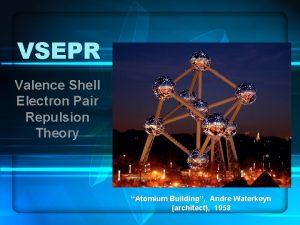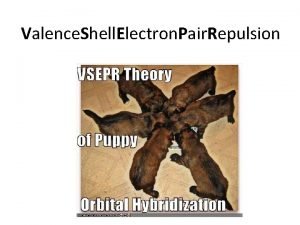VSEPR THEORY Valence Shell Electron Pair Repulsion Theory











- Slides: 11

VSEPR THEORY (Valence Shell Electron Pair Repulsion Theory) Take notes on the slides Adapted from Mr. M. Mc. Isaac Carleton North High School, Bristol, NB t

n While going through this powerpoint, visit the following website to see the animated VSEPR Shapes n http: //www. chemmybear. com/shapes. ht ml n Click on each of the animated shapes 2

What Is The VSEPR Theory? n n VSEPR Theory is used to predict the shapes of molecules. Think of bonded pairs or BP (shared) or lone pairs or LP (nonbonded, unshared) n n To achieve the most stable condition: n n n e-’s are negatively charged clouds that repel each other. clouds must be as far apart as possible in 3 -D, thereby decreasing repulsion. The amount of repulsion can be ordered: LP-LP > LP-BP > BP-BP In order to determine the shape, the Lewis dot structures must be drawn first. 3

2 Bond Pairs/Electron Groups n n Molecules that only have 2 bonding pairs(BP) on the central atom will have a LINEAR SHAPE with a bond angle of 180° e. g. Be. F 2, CO 2, CS 2 General Formula: AX 2 Central atom A from group 2; 2 BP 0 LP 4

3 Bond Pairs/Electron Groups Molecules that have 3 bonding pairs on the central atom will have a TRIGONAL PLANAR SHAPE with bond angles of 120°. n e. g. BF 3, BH 3 n General Formula: AX 3 n Central atom A from group 13; 3 BP 0 LP n 5

4 Bonding Pairs/Electron Groups n If the central atom is placed at the center of a sphere, than each of the four pairs of electrons will occupy a position to be as far apart as possible. n n n results in the electron pairs being at the corners of a regular tetrahedron these molecules are said to have a TETRAHEDRAL SHAPE. The angle between each bond will be 109. 5° e. g. CCl 4, CH 4, Si. H 4 General Formula: AX 4 Central atom A from group 14; 4 BP 0 LP 6

Example CCl 4 7

3 Bonding Pairs(BP) & 1 Nonbonding (LP) Pair n n n n Four pairs of electrons will always arrange themselves tetrahedrally around the central atom. The shape of the molecule is determined by the arrangement of the atoms not the electrons. As a result such molecules will have a TRIGONAL PYRAMIDAL shape. Due to the repulsion, a non-bonding electron pair (LP) requires more space than a bonding pair (BP), the angles in these molecules are 107° not 109. 5° as in the tetrahedral molecules. e. g. NH 3, PCl 3 General Formula: AX 3 E Central atom A from group 15; 3 BP 1 LP 8

Example NH 3 9

2 Bonding Pairs (BP)& 2 Nonbonding Pairs (LP) n n n n The four pairs of electrons will be arranged tetrahedrally but since only 2 pairs are bonding electrons, the surrounding atoms are at 2 corners of the tetrahedron. As a result these molecules will have a VSHAPE or BENT. The repulsion between the non-bonding pairs (LP) will result in a bond angle of 104. 5°. For each pair of non-bonding electrons, the bond angle decreases by 2. 5° e. g. H 2 O, H 2 S, OCl 2 General Formula: AX 2 E 2 Central atom A from group 16; 2 BP 2 LP 10

Example H 2 O 11
 Valence shell electron pair repulsion
Valence shell electron pair repulsion Valence shell electron pair repulsion
Valence shell electron pair repulsion Sof4 lewis structure
Sof4 lewis structure Shell cleanliness shell soundness shell
Shell cleanliness shell soundness shell Egg parts diagram
Egg parts diagram Valence electrons and electron configuration
Valence electrons and electron configuration Full valence shell period 3
Full valence shell period 3 Gramatický větný vzorec
Gramatický větný vzorec Valence shell
Valence shell Pf3 number of vsepr electron groups
Pf3 number of vsepr electron groups Pf3 number of vsepr electron groups
Pf3 number of vsepr electron groups Hydrogen chloride lewis structure
Hydrogen chloride lewis structure
